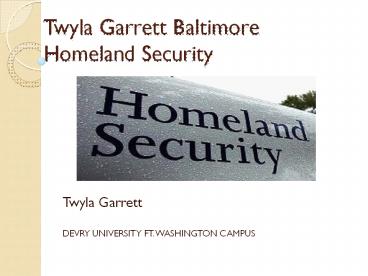Twyla Garrett Baltimore Future of homeland security PowerPoint PPT Presentation
Title: Twyla Garrett Baltimore Future of homeland security
1
Twyla Garrett BaltimoreHomeland Security
- Twyla Garrett
- DEVRY UNIVERSITY FT. WASHINGTON CAMPUS
2
Homeland Security
- DHS was created November 25, 2003 with the
signing of the Homeland Security Act of 2002 - DHS combined 22 federal agencies/programs with
roughly 1,200 employees. - Direct response to September 2001 attacks
- Foci on security of civil aviation and protection
of US borders the major vulnerabilities
revealed on 9-11-01 - Homeland Security, prior to DHS, was a policy
arena characterized by a competition between DOD
and DOJ
3
Components of Homeland Security
- US Department of the Treasury
- Customs Service
- Secret Service
- Federal Emergency Management Agency
- Government Services Administration
- Federal Protective Service
- Federal Computer Incident Response Center
4
DHS Manpower in 2003
- USCG 43,639 employees
- TSA 41,300/70,000 employees
- INS/Border Patrol 39,459 employees
- Customs Service 21,743 employees
- Animal and Plant Health Inspection Service
8,620 employees - Secret Service 6,111 employees
- FEMA 5,135 employees (2.5-3 of DHS total)
5
DHS Mission
- We will lead the unified national effort to
secure America. We will prevent and deter
terrorist attacks and protect against and respond
to threats and hazards to the nation. We will
ensure safe and secure borders, welcome lawful
immigrants and visitors, and promote the
free-flow of commerce.
6
Expected Strengths
- Some very successful programs but success does
not always mean survival when administrations
change - Strong working relationships with state and local
counterparts in some agencies - Strong working relationships with private and
nonprofit partners in some agencies - Increasing transparency and openness in working
with the public and with state and local
officials
7
Expected Obstacles
- Intra-organizational problems integration of 22
agencies/programs military, law enforcement,
agriculture, biomedicine, disaster relief,
insurance, fire service, etc. - Inter-organizational problems coordination with
the estimated 100 agencies in 12 departments
outside of DHS involved in Homeland Security - Political problems due to turf battles among the
88 separate Congressional committees having
oversight
8
Expected Obstacles
- Mission problems reconciling DHS non-terrorism
related missions especially insurance and
disaster recovery missions - Shared responsibility problems nations
intelligence capabilities, namely the CIA and
FBI, not part of DHS, but critical to security - Agency administrative problems - Uncertainties
concerning problem agencies, especially Border
Patrol, INS, and Customs Service - Civil Service-related administrative problems
e.g., demographic bubble
9
Mission Problems
- Declining public support for the Iraq War the
ambiguous War on Terrorism - Decreasing private sector willingness to invest
in security - Increasing conflicts with state and local
counterparts over priorities, funding, etc. - Increasing questions concerning capabilities to
do non-counter-terrorism missions e.g., the
2004 Baltimore hurricane response
10
Issues to Be Resolved
- How to expand from a prevention approach to an
all-hazards approach NRP controversy - How to expand focus from counter-terrorism to
dealing with other threats to life and property - How to develop mitigation programs for terrorism
as well as for natural and technological hazards - How to transition from prevention to mitigation,
response, and recovery functions when attacks
cannot be prevented
11
Issues to Be Resolved
- How to improve intra-organizational and
inter-organizational information sharing - How to resolve turf and culture battles to
coordinate national efforts - TOPOFF problems - How to build state and local capabilities to
respond to terrorist and non-terrorist threats - How to involve nongovernmental organizations and
volunteers the traditional disaster system
resources in Homeland Security the Citizens
Corps controversy - How to leverage private sector resources for
national Homeland Security efforts, including how
to get the private sector to protect itself

